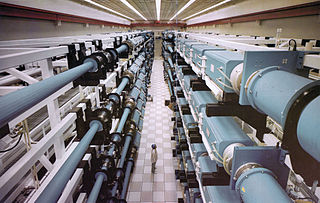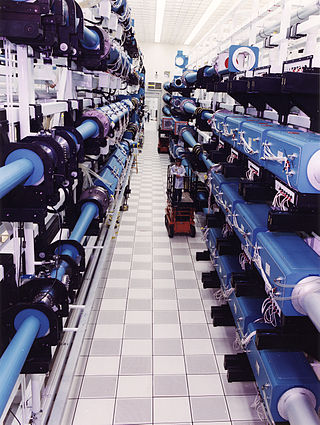Related Research Articles

Nuclear fusion is a reaction in which two or more atomic nuclei, usually deuterium and tritium, combine to form one or more different atomic nuclei and subatomic particles. The difference in mass between the reactants and products is manifested as either the release or absorption of energy. This difference in mass arises due to the difference in nuclear binding energy between the atomic nuclei before and after the reaction. Nuclear fusion is the process that powers active or main-sequence stars and other high-magnitude stars, where large amounts of energy are released.

In physics, a state of matter is one of the distinct forms in which matter can exist. Four states of matter are observable in everyday life: solid, liquid, gas, and plasma. Many intermediate states are known to exist, such as liquid crystal, and some states only exist under extreme conditions, such as Bose–Einstein condensates and Fermionic condensates, neutron-degenerate matter, and quark–gluon plasma.

Inertial confinement fusion (ICF) is a fusion energy process that initiates nuclear fusion reactions by compressing and heating targets filled with fuel. The targets are small pellets, typically containing deuterium (2H) and tritium (3H).
Metallic hydrogen is a phase of hydrogen in which it behaves like an electrical conductor. This phase was predicted in 1935 on theoretical grounds by Eugene Wigner and Hillard Bell Huntington.
This timeline of nuclear fusion is an incomplete chronological summary of significant events in the study and use of nuclear fusion.
The oxygen-burning process is a set of nuclear fusion reactions that take place in massive stars that have used up the lighter elements in their cores. Oxygen-burning is preceded by the neon-burning process and succeeded by the silicon-burning process. As the neon-burning process ends, the core of the star contracts and heats until it reaches the ignition temperature for oxygen burning. Oxygen burning reactions are similar to those of carbon burning; however, they must occur at higher temperatures and densities due to the larger Coulomb barrier of oxygen.

The National Ignition Facility (NIF) is a laser-based inertial confinement fusion (ICF) research device, located at Lawrence Livermore National Laboratory in Livermore, California, United States. NIF's mission is to achieve fusion ignition with high energy gain. It achieved the first instance of scientific breakeven controlled fusion in an experiment on December 5, 2022, with an energy gain factor of 1.5. It supports nuclear weapon maintenance and design by studying the behavior of matter under the conditions found within nuclear explosions.
Quark matter or QCD matter refers to any of a number of hypothetical phases of matter whose degrees of freedom include quarks and gluons, of which the prominent example is quark-gluon plasma. Several series of conferences in 2019, 2020, and 2021 were devoted to this topic.

Nova was a high-power laser built at the Lawrence Livermore National Laboratory (LLNL) in California, United States, in 1984 which conducted advanced inertial confinement fusion (ICF) experiments until its dismantling in 1999. Nova was the first ICF experiment built with the intention of reaching "ignition", a chain reaction of nuclear fusion that releases a large amount of energy. Although Nova failed in this goal, the data it generated clearly defined the problem as being mostly a result of Rayleigh–Taylor instability, leading to the design of the National Ignition Facility, Nova's successor. Nova also generated considerable amounts of data on high-density matter physics, regardless of the lack of ignition, which is useful both in fusion power and nuclear weapons research.

Inertial Fusion Energy is a proposed approach to building a nuclear fusion power plant based on performing inertial confinement fusion at industrial scale. This approach to fusion power is still in a research phase. ICF first developed shortly after the development of the laser in 1960, but was a classified US research program during its earliest years. In 1972, John Nuckolls wrote a paper predicting that compressing a target could create conditions where fusion reactions are chained together, a process known as fusion ignition or a burning plasma. On August 8, 2021, the NIF at Livermore National Laboratory became the first ICF facility in the world to demonstrate this. This breakthrough drove the US Department of Energy to create an Inertial Fusion Energy program in 2022 with a budget of 3 million dollars in its first year.

The High Power laser Energy Research facility (HiPER), is a proposed experimental laser-driven inertial confinement fusion (ICF) device undergoing preliminary design for possible construction in the European Union. As of 2019, the effort appears to be inactive.
Trisops was an experimental machine for the study of magnetic confinement of plasmas with the ultimate goal of producing fusion power. The configuration was a variation of a compact toroid, a toroidal (doughnut-shaped) structure of plasma and magnetic fields with no electromagnetic coils or electrodes penetrating the center. It lost funding in its original form in 1978.
Rydberg matter is an exotic phase of matter formed by Rydberg atoms; it was predicted around 1980 by É. A. Manykin, M. I. Ozhovan and P. P. Poluéktov. It has been formed from various elements like caesium, potassium, hydrogen and nitrogen; studies have been conducted on theoretical possibilities like sodium, beryllium, magnesium and calcium. It has been suggested to be a material that diffuse interstellar bands may arise from. Circular Rydberg states, where the outermost electron is found in a planar circular orbit, are the most long-lived, with lifetimes of up to several hours, and are the most common.

Plasma is one of four fundamental states of matter characterized by the presence of a significant portion of charged particles in any combination of ions or electrons. It is the most abundant form of ordinary matter in the universe, mostly in stars, but also dominating the rarefied intracluster medium and intergalactic medium. Plasma can be artificially generated, for example, by heating a neutral gas or subjecting it to a strong electromagnetic field.
Fusion ignition is the point at which a nuclear fusion reaction becomes self-sustaining. This occurs when the energy being given off by the reaction heats the fuel mass more rapidly than it cools. In other words, fusion ignition is the point at which the increasing self-heating of the nuclear fusion removes the need for external heating. This is quantified by the Lawson criterion. Ignition can also be defined by the fusion energy gain factor.

William J. Nellis is an American physicist. He is an Associate of the Physics Department of Harvard University. His work has focused on ultra-condensed matter at extreme pressures, densities and temperatures achieved by fast dynamic compression. He is most well-known for the first experimental observation of a metallic phase of dense hydrogen, a material predicted to exist by Eugene Wigner and Hillard Bell Huntington in 1935.
The history of nuclear fusion began early in the 20th century as an inquiry into how stars powered themselves and expanded to incorporate a broad inquiry into the nature of matter and energy, as potential applications expanded to include warfare, energy production and rocket propulsion.
In plasma physics, a burning plasma is a plasma that is heated primarily by fusion reactions involving thermal plasma ions. The Sun and similar stars are a burning plasma, and in 2020 the National Ignition Facility achieved a burning plasma in the laboratory. A closely related concept is that of an ignited plasma, in which all of the heating comes from fusion reactions.

Andrea Lynn "Annie" Kritcher is an American nuclear engineer and physicist who works at the Lawrence Livermore National Laboratory. She was responsible for the development of Hybrid-E, a capsule that enables inertial confinement fusion. She was elected Fellow of the American Physical Society in 2022.
References
- ↑ National Academies of Sciences, Engineering, and Medicine (2023). Fundamental Research in High Energy Density Science. Washington, D.C.: National Academies Press. doi:10.17226/26728. ISBN 978-0-309-69414-8.
{{cite book}}: CS1 maint: multiple names: authors list (link) - ↑ "Home". heds-center.llnl.gov.
- 1 2 3 4 "High energy density science: Research areas". Lawrence Livermore National Laboratory, US Department of Energy. Archived from the original on 2019-02-13. Retrieved 2019-02-13.
 This article incorporates text from this source, which is in the public domain .
This article incorporates text from this source, which is in the public domain . - ↑ Bergeson, Scott D.; Baalrud, Scott D.; Ellison, C. Leland; Grant, Edward; Graziani, Frank R.; Killian, Thomas C.; Murillo, Michael S.; Roberts, Jacob L.; Stanton, Liam G. (2019-10-01). "Exploring the crossover between high-energy-density plasma and ultracold neutral plasma physics". Physics of Plasmas. 26 (10): 100501. Bibcode:2019PhPl...26j0501B. doi: 10.1063/1.5119144 . ISSN 1070-664X.